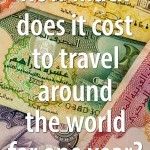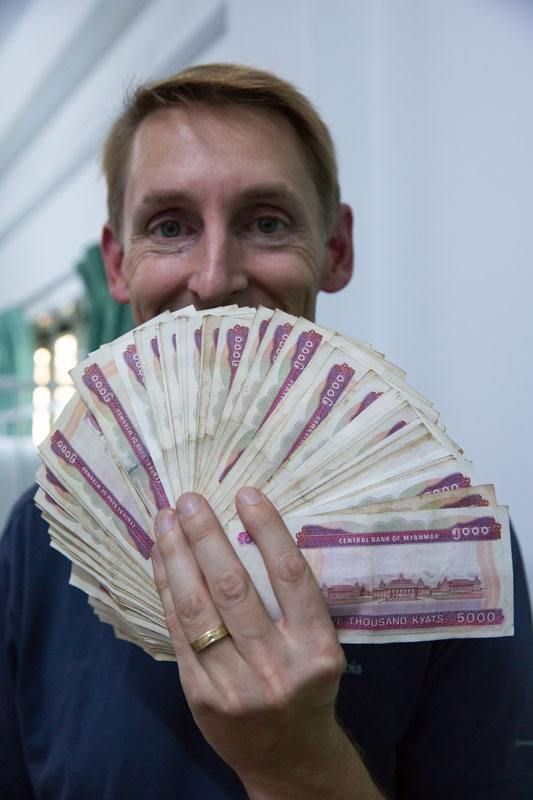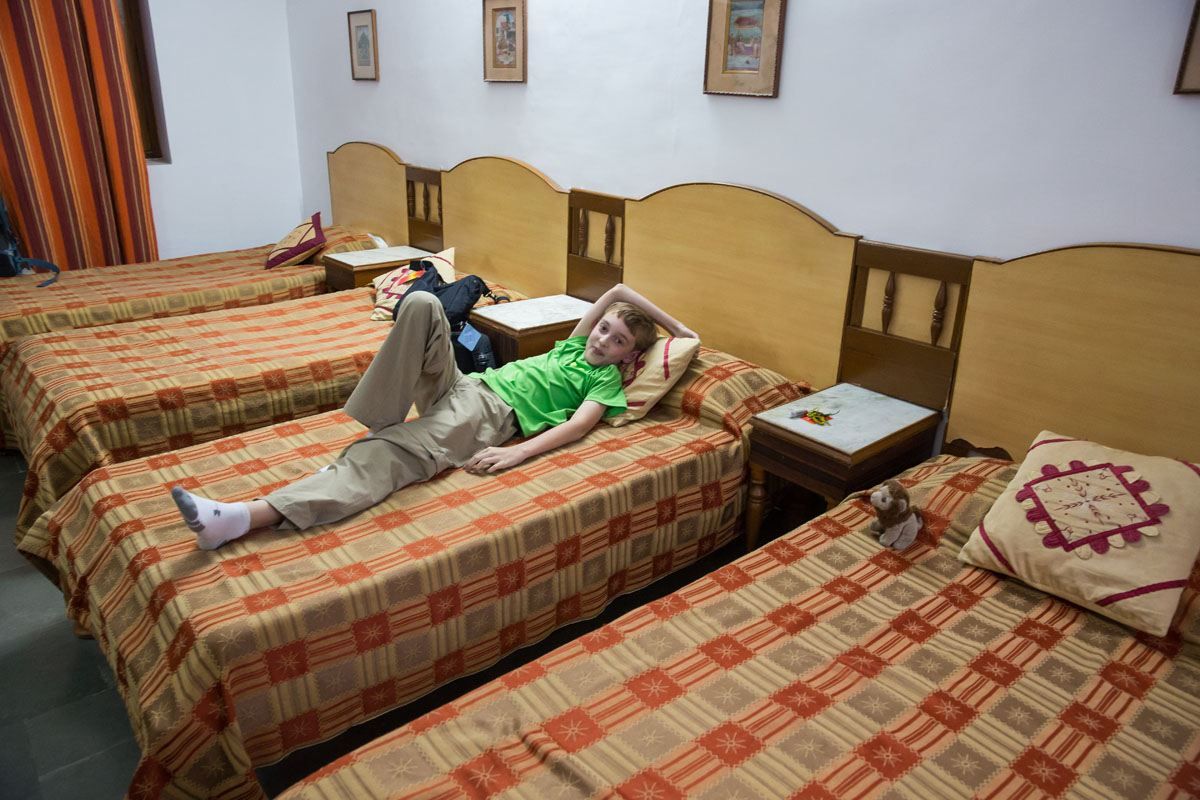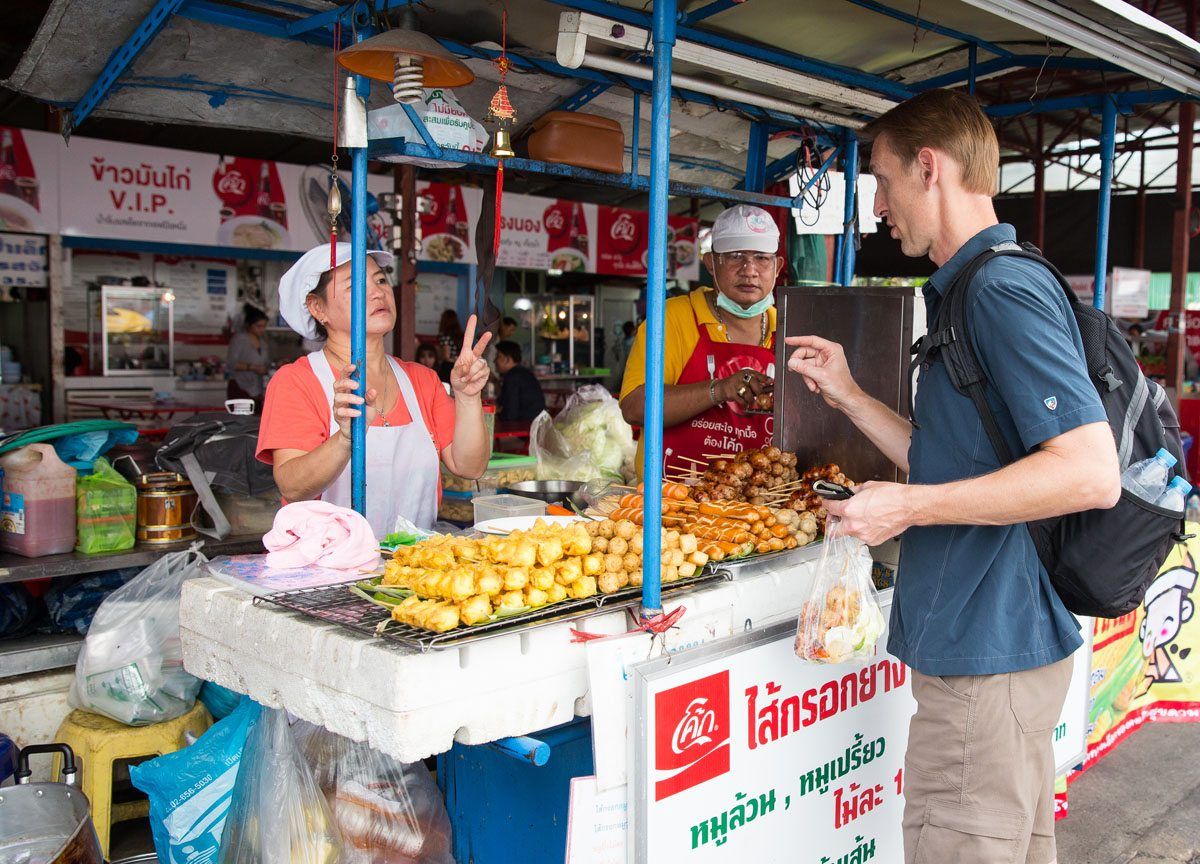How Much Does It Cost to Travel Around the World?

One of the most popular questions we get asked is how much does it cost to travel around the world. This was our biggest question too, before we decided to take a big trip like this.
It costs a lot less than you probably think. Traveling long term, several months or longer, costs a lot less per day than what you might normally spend on a typical 10 day overseas trip.
There are a lot of factors that influence how much you will spend…which countries you visit, the types of accommodations you stay in, how often you move between cities, your mode of transportation, and how many tours and activities you do. In this post, we will shed some light on the costs associated with around the world travel, and give you a ballpark estimate on what to expect if you have plans for a trip like this.
Table of Contents
Factors that Influence the Cost of Long-Term Travel
The Countries you Visit

If you spend a lot of your time in developed countries (Europe, Australia, New Zealand, and Japan) your costs will be very high. In Europe and Australia, per person costs average $125 per day. For our family of four, we averaged $350 per day in these countries.
Asia, Africa, and South America are cheaper. In places like Cambodia, India, and Nepal, you can spend as little as $50 per person per day and still eat well and stay in nice accommodations. Our family of four averaged $185 per day in Southeast Asia, $180 per day in Nepal, and $155 per day in India.
Planning your trip such that you visit more countries with a lower cost of living will help you keep your expenses down. And that is what we did, while making sure they were still countries we were interested in visiting.
During our 13 months of travel, we spent nine of them in Asia. We also spent six weeks in Southern Africa. These countries are on the cheaper end of the scale. We limited our time in New Zealand and Australia to seven weeks and we limited our time in Europe to just five weeks. All of these are on the more expensive end of the scale. We also knew we could travel back to Europe in the future more easily than we could Asia because of the travel distances from where we call home.
A budgeting resource we used is budgetyourtrip.com. This is a good resource if you want to get basic daily expenses for each country. Simply type in the name of the country and you will get an estimate of the average daily cost to visit that country. This is just an estimate, but it gives you a starting point of how much you can expect to spend in each country.
Mode of Transportation

Your primary mode of transportation will have a huge impact on your budget. Plane flights are the most expensive, whereas bus travel is extremely cheap. If you really want to keep your budget low, limit your flights and fill in the gaps with bus and train travel.
But remember, you get what you pay for. Bus travel is a very cost effective way of traveling, but it’s also slow and can get incredibly frustrating. When you are traveling long-term, you have the luxury of time, so adding in a day for travel between Bangkok and Chiang Mai may be worth the savings over the airplane flight.
What We Did:
In Europe, we traveled through Italy on the train and occasionally used the public buses. Once in Germany, we rented a car simply for the convenience of touring Bavaria.
While in Southern Africa, we rented a car for the entire six weeks we were there. We drove a lot, but saved a ton of money since we didn’t have to book flights for the four of us.
While in Asia, we booked airplane flights for our longer hops and filled in the gaps with bus travel. We did take an occasional flight out of convenience. For example, to travel between Laos and Cambodia, it was going to be two bus journeys taking over 24 hours that would have cost just a little bit less than a plane flight. In circumstances like these, it was a no-brainer to take the flight.
We toured New Zealand from bottom to the top in a car, our best road trip ever. In Australia, we primarily traveled by car but we did fly between some destinations.
All in all, over our 13 month journey, we traveled on 90 buses, 56 trains, and 44 airplanes.
Pace of Travel
The more frequently you change location, the more money you spend. Every time you transfer to a new place, you have to spend money on transportation, which increases your daily expenditures.
Many people, when they travel for a year, hop from place to place about every week or two. Some stay a month or longer, really getting to know a place. And, since there are no transportation costs during this time, expenses are usually very low.
The slower you travel, the lower your daily costs.
What We Did:
We were different. We moved very frequently, averaging just three days per city. In 396 days, we slept in 149 different places. Our costs were higher because we moved so frequently.
For us, it was worth it. This was a once in a lifetime opportunity and we wanted to see as much of the world as possible. It was exhausting and we were burnt out towards the end of the year, but I’d do it exactly the same again.
Type of Accommodations
Accommodations can easily be one of the biggest ticket items in your budget. So saving money here saves a lot of money overall.
During long-term travel, most people stay in two or three star accommodations, hostels, or apartment rentals. If you are traveling solo, hostels are usually the most economical, because you can rent a bed for the night instead of an entire room for the night. The downside is that you will be sharing a bedroom and bathroom with other people. But on the flip side it provides a social environment for meeting other travelers.
Hostels and apartment rentals typically provide kitchen access. So you can save even more money by preparing your own food when staying in these types of accommodations.
Of course, there are always exceptions to the rule, but accommodations in order of least expensive to most expensive are:
- Couchsurfing
- Camping
- Hostels
- Long-term budget rentals
- Low-budget hotels and B&B’s
- Midrange hotels and B&B’s
- Luxury hotels and B&B’s
When planning your travels, it’s easy to say that you will just stay in low budget, economical places 100% of the time. But every once in a while, it is really nice to splurge. After going budget for so long, those little extras you get at a better place will really, really seem nice.
If you are traveling as a family, hostels usually are not more economical, since they charge per person. We had much better luck in bed and breakfasts, cheaper hotels, and apartment rentals.
Another way to keep costs low is to combine your transportation costs with accommodation costs. Booking overnight trains and buses are great ways to save money.
What we did:
Primarily, we stayed in 2 to 3 star bed and breakfasts and homestays. A homestay is basically a room in someone’s house that is set up similar to a hotel room. These were great because we got more personal attention, they were flexible with keeping all four of us together in the same room, and sometimes they would cook us dinner (for an extra fee). And it was an opportunity to immerse ourselves in the local community and gain a better appreciation of how the locals lived.
Most of the time, we all slept in one room. This really kept costs down, since we only had to pay for one room. In Asia, if we asked, hotel staff were usually accommodating in adding cots or extra mattresses to the room. It took some adjusting being together all of the time, but it was one of the main ways we saved money.

Every once in a while we did splurge, either to have access to a hotel pool, have a great view (a watering hole with elephants in Botswana!), stay in a unique hotel (silos in New Zealand), or get a dose of luxury (a villa in Bali for our wedding anniversary). But places like these were few and far between for us on our trip around the world.
Food
Food is another item that adds up fast on the trip budget. If you are really trying to keep costs down, minimize your visits to restaurants and maximize your visits to grocery stores. Preparing your own meals will save money.
Dining out every day gets expensive, even in cheaper countries. Alcohol, even just a glass of wine, can start to break the budget.
Eating the local food is much cheaper than dining in restaurants that serve a western menu. Sometimes, your best bet for good, cheap food are the street food stalls. Just pick a place that gets a lot of business and always seems to have a line to avoid a case of food poisoning.

Activities, Tours, and Multi-Day Excursions
This is the fun part of traveling and yes, you do have to budget for it. Museum entrance fees, guided tours, zip lining, surf lessons, concerts, and excursions all need to be accounted for in your budget. So, how much do you need to add?
That’s a tough question. The answer depends on what you like to do. Hiking can be an inexpensive way to explore a place. Exploring a city on your own and visiting the free museums is a way to go sightseeing for the least amount of money. Add in a little bit of money for those other must-see sites. Once you start adding in activities such as food tours or adventure sports your costs will really go up.
Budgeting for activities can be very difficult because in most circumstances, you are not going to know what you want to do until you get there. And you do not want to fall into the trap of not doing anything because it will cost you money. Just remember why you are traveling in the first place.

If you plan to do a big ticket activity, such as going on safari in Africa, trekking in Nepal, or taking an expensive, multi-day excursion, put this money aside so it will be easier to manage your normal daily expenses. Most likely, these are activities that you are budgeting for during the planning phase anyway.
If there is something that you really want to do, then do it. You’ll regret it later if you don’t. Just balance out the cost of the activity with your other expenses. Find cheaper places to stay, cook more of your own meals, etc.
What We Did:
One of the main reasons we stayed in cheaper accommodations and took more buses is so that we had the money to spend on activities. We wanted to experience as much as possible. That meant if some amazing opportunity presented itself, we took it.
Now, that doesn’t mean we did every single thing we wanted to. We did have to pick and choose quite a bit. And if we spent money on an expensive activity, for the next day or two we had to find cheaper food options to make up the difference.
We also felt like we would get more out of the activities than nicer accommodations, creating lasting memories of our travels. Turns out that some of our budget accommodations and cheaper food options created lasting memories as well. So it was a win-win right?
Those Miscellaneous Fees
Unavoidably, you will spend money on miscellaneous fees, such as visas on arrival, souvenirs, laundry, replacing worn clothing, buying new gear, and for other unaccounted items as you travel. Many people advise having between $1,000 and $2,000 set aside to be used in these circumstances.
Pre-Trip Expenses
Unfortunately, there are more expenses to consider: those upfront costs that you will spend even before you set foot on that first airplane. These costs include plane flights, vaccinations, visas needed in advance, travel gear, travel insurance, health insurance, homeschooling materials, etc.
So, How Much Does it Cost?
In general, you should expect it to cost between $25,000 to $35,000 per person to travel around the world for a year. This rough estimate comes from reading travel budgets of other bloggers, various travel planning resources, and our own experience.
This is just the midrange. Yes, you can absolutely travel for less than $25,000 per person for an entire year. Many people have done it and written about it. Or, you could spend more for luxury, traveling for $50,000 to $60,000 or more per person.
The bottom line is that if you are a solo traveler, you should be able to travel the world for $25,000 for one year (that’s just over $2,000 per month, $66 per day)!!
Want to travel the world as a family, like we did? Try to do so before your kids turn 12. Most travel expenses, airline fees, activities, etc., are cheaper for kids under 12 years of age.
What’s Next?
If you are considering long-term travel, your next steps are to come up with a basic itinerary, determine your traveling style, and start making your travel budget.
Here are some more articles that can help you as you plan your around the world trip:
How to Design an Around the World Itinerary
RTW Ticket vs. One Way Ticket, Which One is Better?
Our Around the World Packing List
One Year Around the World
Or, check out our entire page devoted to around the world travel, including planning your trip, what to expect on the road, and what it is like to finally come home.
How to Travel Around the World
If you have questions, comment below or send us an email.
Cheers!

All rights reserved © Earth Trekkers. Republishing this article and/or any of its contents (text, photography, etc.), in whole or in part, is strictly prohibited.















![Toni Kroos là ai? [ sự thật về tiểu sử đầy đủ Toni Kroos ]](https://evbn.org/wp-content/uploads/New-Project-6635-1671934592.jpg)


